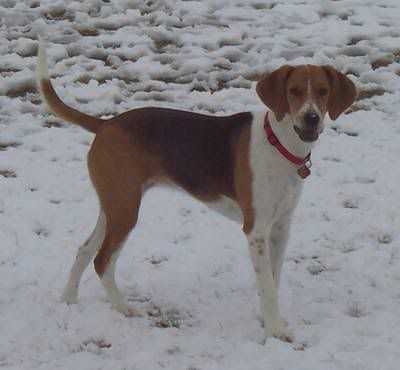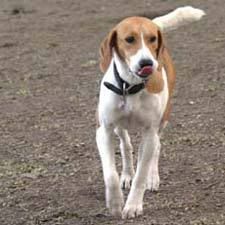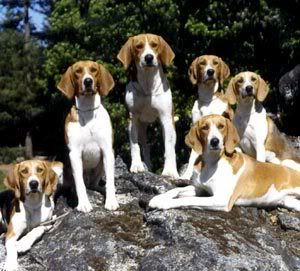Post by charmingnancy on Jan 13, 2009 14:13:28 GMT -5
Harrier
Group: 2- Hounds
Origin: United Kingdom
Purpose: Hunting hares

Description:
The Harrier is a small to medium sized dog breed of the hound class, used for hunting hares by trailing them. It resembles an English Foxhound but is smaller, though not as small as a Beagle.
Appearance- Breed Standards:
Coat and Colour:
Coat – Short, dense, hard and glossy. Coat texture on the ears is finer than on the body. There is a brush of hair on the underside of the tail.
Colour – Any colour, not regarded as very important.
Head: The head is in proportion to the overall dog. No part of the head should stand out relative to the other parts. The expression is gentle when relaxed, sensible yet alert when aroused. Eyes are almond shaped, medium size, set well apart, brown or hazel colour in darker dogs. Lighter hazel to yellow in lighter dogs, though darker colours are always desired. Ears are set on low and lie close to the cheeks, rounded at the tips. The skull is in proportion to the entire animal, with good length and breadth and a bold forehead. The stop is moderately defined. The muzzle from stop to tip of nose is approximately the same length as the skull from stop to occiput. The muzzle is substantial with good depth, and the lips complete the square, clean look of the muzzle, without excess skin or flews. A good nose is essential. It must be wide, with well opened nostrils. Teeth meet in a scissors bite or they may be level. Overshot or undershot bites faulted to the degree of severity of the misalignment.
Neck: The neck is long and strong with no excess skin or throatiness, sweeping smoothly into the muscling of the forequarters.
Forequarters: Moderate angulation, with long shoulders sloping into the muscles of the back, clean at the withers. The shoulders are well clothed with muscle without being excessively heavy or loaded, giving the impression of free, strong action. Elbows are set well away from the ribs, running parallel with the body and not turning outwards. Good straight legs with plenty of bone running well down to the toes, but not overburdened, inclined to knuckle over very slightly but not exaggerated in the slightest degree. Feet are round and catlike, with toes set close together turning slightly inwards. The pads are thick, well developed and strong.
Body: The topline is level. Back muscular with no dip behind the withers or roach over the loin. Chest deep, extending to the elbows, with well sprung ribs that extend well back, providing plenty of heart and lung room. The ribs should not be so well sprung that they interfere with the free, efficient movement of the front assembly. The loin is short, wide and well muscled.
Hindquarters: Angulation in balance with the front assembly, so that rear drive is in mharmony with front reach. Well developed muscles, providing strength for long hours of work, are important. Endurance is more important than pure speed, and as such, the stifles are only moderately angulated. Feet point straight ahead, are round and catlike with toes set close together, and thick, well developed pads.
Tail; The tail is long, set on high and carried upwards. It tapers to a point with a brush of hair.
Gait: Perfect coordination between the front and hind legs. Reach and drive are consistent with the desired moderate angulation. Coming and going, the dog moves in a straight line, evidencing no sign of crabbing. A slight toeing-in of the front feet is acceptable. Clean movement coming and going is as important as side gait, which is smooth and ground-covering.
Size:
19 to 21 inches for dogs and bitches, variation of one inch in either
direction is acceptable. Proportion is off square. The Harrier is slightly longer from point of shoulder to rump than from withers to ground. The body is solidly built, full of strength and quality. The breed has as much substance and bone as possible without being heavy or coarse. Adults weigh between 45 and 60 lbs.

Temperament:
The Harrier is cheerful, sweet-tempered, tolerant, and it is excellent with children. This pack dog is good with other dogs, but should be supervised with noncanine pets unless it is raised with them from puppyhood. It prefers life in a pack with people, dogs, or both. This active dog likes to go exploring, sniffing, and trailing, so be sure to keep it on a leash or in a safe enclosed area. Some Harriers like to bay.
Health:
Hip dysplasia is known to occur in this breed.
Average Lifespan:
This breed's lifespan is generally 10-12 years.
History:
Sources have widely conflicting stories about the origins of this breed. According to one, the earliest Harrier types were crossed with Bloodhounds, the Talbot Hound, and even the Basset Hound. According to another, the breed was probably developed from crosses of the English Foxhound with Fox Terrier and Greyhound. And yet another, the Harrier is said to be simply a bred-down version of the English Foxhound. The first Harrier pack in England was established by Sir Elias de Midhope in 1260 and spread out as a hunting dog throughout the west of England and into Wales. Although there are many working Harriers in England the breed is still not recognized in that country.
In any case, today's Harrier is between the Beagle and English Foxhound in size and was developed primarily to hunt hares, though the breed has also been used in fox hunting. The name, Harrier, reveals the breed's specialty. The Harrier is still fairly rare in the United States, but has a long history of popularity as a working pack dog in England.

Sources:
Wikipedia
[url=http://www.ckc.ca/en/Portals/0/breeds/HRI.pdf
]CKC[/url]
Pictures:
Photobucket[/size]
Group: 2- Hounds
Origin: United Kingdom
Purpose: Hunting hares

Description:
The Harrier is a small to medium sized dog breed of the hound class, used for hunting hares by trailing them. It resembles an English Foxhound but is smaller, though not as small as a Beagle.
Appearance- Breed Standards:
Coat and Colour:
Coat – Short, dense, hard and glossy. Coat texture on the ears is finer than on the body. There is a brush of hair on the underside of the tail.
Colour – Any colour, not regarded as very important.
Head: The head is in proportion to the overall dog. No part of the head should stand out relative to the other parts. The expression is gentle when relaxed, sensible yet alert when aroused. Eyes are almond shaped, medium size, set well apart, brown or hazel colour in darker dogs. Lighter hazel to yellow in lighter dogs, though darker colours are always desired. Ears are set on low and lie close to the cheeks, rounded at the tips. The skull is in proportion to the entire animal, with good length and breadth and a bold forehead. The stop is moderately defined. The muzzle from stop to tip of nose is approximately the same length as the skull from stop to occiput. The muzzle is substantial with good depth, and the lips complete the square, clean look of the muzzle, without excess skin or flews. A good nose is essential. It must be wide, with well opened nostrils. Teeth meet in a scissors bite or they may be level. Overshot or undershot bites faulted to the degree of severity of the misalignment.
Neck: The neck is long and strong with no excess skin or throatiness, sweeping smoothly into the muscling of the forequarters.
Forequarters: Moderate angulation, with long shoulders sloping into the muscles of the back, clean at the withers. The shoulders are well clothed with muscle without being excessively heavy or loaded, giving the impression of free, strong action. Elbows are set well away from the ribs, running parallel with the body and not turning outwards. Good straight legs with plenty of bone running well down to the toes, but not overburdened, inclined to knuckle over very slightly but not exaggerated in the slightest degree. Feet are round and catlike, with toes set close together turning slightly inwards. The pads are thick, well developed and strong.
Body: The topline is level. Back muscular with no dip behind the withers or roach over the loin. Chest deep, extending to the elbows, with well sprung ribs that extend well back, providing plenty of heart and lung room. The ribs should not be so well sprung that they interfere with the free, efficient movement of the front assembly. The loin is short, wide and well muscled.
Hindquarters: Angulation in balance with the front assembly, so that rear drive is in mharmony with front reach. Well developed muscles, providing strength for long hours of work, are important. Endurance is more important than pure speed, and as such, the stifles are only moderately angulated. Feet point straight ahead, are round and catlike with toes set close together, and thick, well developed pads.
Tail; The tail is long, set on high and carried upwards. It tapers to a point with a brush of hair.
Gait: Perfect coordination between the front and hind legs. Reach and drive are consistent with the desired moderate angulation. Coming and going, the dog moves in a straight line, evidencing no sign of crabbing. A slight toeing-in of the front feet is acceptable. Clean movement coming and going is as important as side gait, which is smooth and ground-covering.
Size:
19 to 21 inches for dogs and bitches, variation of one inch in either
direction is acceptable. Proportion is off square. The Harrier is slightly longer from point of shoulder to rump than from withers to ground. The body is solidly built, full of strength and quality. The breed has as much substance and bone as possible without being heavy or coarse. Adults weigh between 45 and 60 lbs.

Temperament:
The Harrier is cheerful, sweet-tempered, tolerant, and it is excellent with children. This pack dog is good with other dogs, but should be supervised with noncanine pets unless it is raised with them from puppyhood. It prefers life in a pack with people, dogs, or both. This active dog likes to go exploring, sniffing, and trailing, so be sure to keep it on a leash or in a safe enclosed area. Some Harriers like to bay.
Health:
Hip dysplasia is known to occur in this breed.
Average Lifespan:
This breed's lifespan is generally 10-12 years.
History:
Sources have widely conflicting stories about the origins of this breed. According to one, the earliest Harrier types were crossed with Bloodhounds, the Talbot Hound, and even the Basset Hound. According to another, the breed was probably developed from crosses of the English Foxhound with Fox Terrier and Greyhound. And yet another, the Harrier is said to be simply a bred-down version of the English Foxhound. The first Harrier pack in England was established by Sir Elias de Midhope in 1260 and spread out as a hunting dog throughout the west of England and into Wales. Although there are many working Harriers in England the breed is still not recognized in that country.
In any case, today's Harrier is between the Beagle and English Foxhound in size and was developed primarily to hunt hares, though the breed has also been used in fox hunting. The name, Harrier, reveals the breed's specialty. The Harrier is still fairly rare in the United States, but has a long history of popularity as a working pack dog in England.

Sources:
Wikipedia
[url=http://www.ckc.ca/en/Portals/0/breeds/HRI.pdf
]CKC[/url]
Pictures:
Photobucket[/size]

